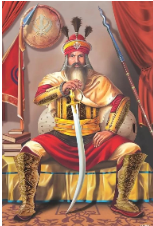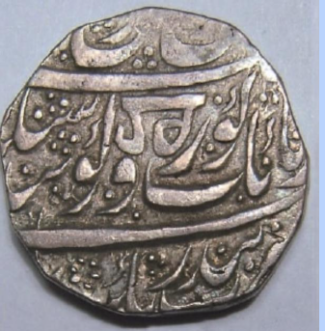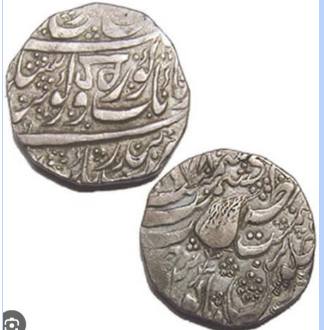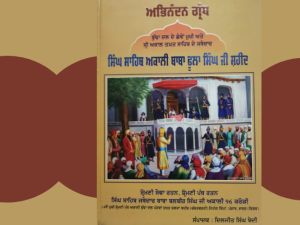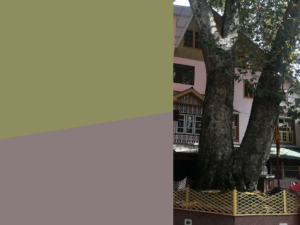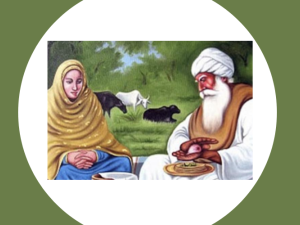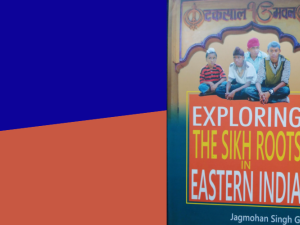The numismatic history of the Sikh Empire reflects not only the vast territorial conquests of the empire but also the remarkable stature of its commanders.
Among the most distinguished of these commanders was Sardar Hari Singh Nalwa, whose legacy was immortalized in the striking of coins in his name—a privilege that was unprecedented among the nobility of Maharaja Ranjit Singh’s court. These coins serve as a testimony to his military brilliance and political significance, especially during his governorships in Kashmir and Peshawar. (Photo Credit :Sarbat Art)
Kashmir Campaign and the First Coinage (1821):
After two failed attempts to subdue the strategic region of Kashmir in 1813 and 1814, Maharaja Ranjit Singh's forces, led by capable generals, including Diwan Chand and Prince Kharak Singh, finally conquered the region in 1819. Hari Singh Nalwa, alongside Sham Singh Attariwala, played a crucial role in this campaign. Upon the victorious entry into Srinagar, a sense of triumph pervaded the Sikh ranks, symbolized by the Persian poet Pandit Hargopal Kaul’s creation of the date of liberation in the words: “Boloji Wahiguru Ji Ka Khalsa, Boloji Wahiguru Ji Ki Fateh.”
In recognition of his exemplary service, Hari Singh Nalwa was appointed as the governor of Kashmir in 1820, following the less effective administration of Diwan Moti Ram. Hari Singh’s governorship lasted two years, during which he won the admiration of the local populace and the approval of the Maharaja.
According to a muslim historian Molana Mohammad Din
“Hari Singh ne Kashmir mein apne naam ka sikka bhi 'jaari kiya jo Hari Singhiya rupiya ke naam se mashhoor hua. Is ki keemat aajkal ke murawaja aath aane ke barabar thi."
Sardar Hari Singh was a symbol of sovereignty, bravery and courage. The major steps taken by him to ensure the peace, harmony and security among the Kashmiri people. His governance was marked by efficiency, just administration, and security for the inhabitants of the valley. His service to the Sikh state was so noteworthy that in 1821, Maharaja Ranjit Singh granted him the rare and distinguished honor of minting coins in his name. These coins were struck in pure silver and were widely recognized as the “Hari Singh Rupee.”
He also circulated copper coins, which was famous as 'HARI SINGHIA PAISA'. Lahore Darbar's Nanak Shahi Sikka (Coin) was minted in Amritsar but it was minted at Srinagar in 1821. On one side of the coin is engraved in Persian 'Zarb Kashmir' 1878 Bikrami' and on the other side.
'Deg-o-Teg-o Fateh Nusrat Bedrang
Yafat Azz Nanak 'Guru Gobind Singh'.
Description of the Hari Singh Rupee:
- Obverse: "Akal Sahai, Sambat 1878" (Translating to 1821 CE, according to the Bikrami calendar)
- Reverse: "Hari Singh, Yak Rupiah" (Hari Singh, one rupee)
This rupee weighed approximately ten mashas and was equivalent to eight annas in the British rupee system, according to Baba Prem Singh’s estimation. The historical significance of this coin is further amplified by Sir Lepel Griffin’s observations, which confirm that the coin was still in circulation in Kashmir as late as 1890, a testament to its durable legacy and respect.All the coins in Sikh rule were issued in Farsi (Persian) language but Hugel has identified a coin used in Punjabi Script.
Peshawar and Second Coinage (1837):
The conquest of Peshawar in 1834 marked another significant victory in Hari Singh Nalwa's illustrious military career. The Afghan forces, led by the Barakzai Sardars, were decisively defeated in the region, and the strategic city of Peshawar fell into Sikh hands on May 6, 1834. Maharaja Ranjit Singh, upon receiving the news of this critical victory, celebrated the event, noting the valor of young Kanwar Naunihal Singh and the tactical brilliance of Hari Singh Nalwa and Mr. Court in his correspondence with the British agent. Following the capture of Peshawar, Hari Singh Nalwa was appointed governor of the newly conquered province, where he successfully maintained order and ensured the protection of both Hindus and Muslims. His ability to manage the complex sociopolitical dynamics of this frontier region won him further acclaim from the Maharaja.
In recognition of his achievements, Hari Singh Nalwa was once again authorized to strike coins in his name in 1837. This second coinage was similarly minted in silver and bore the mark of his authority. According to S.N. Banerjee, this rupee minted in Peshawar was a significant symbol of Nalwa's control over the region and the respect he commanded within the Sikh Empire.
Conclusion: Numismatic Tribute to a Military Icon:
Sardar Hari Singh Nalwa’s coins, minted in 1821 and 1837, are more than just currency; they are symbolic of his extraordinary role in expanding and consolidating the Sikh Empire’s frontier territories. No other dignitary in the Lahore Durbar was accorded the honor of minting coins in their name, making this distinction a unique testimony to Nalwa's unparalleled military prowess and administrative acumen.
The minting of these coins in regions as diverse as Kashmir and Peshawar, both critical to the empire’s stability and security, showcases Nalwa’s significance in shaping the political landscape of North India during the 19th century. His legacy, captured in these coins, continues to offer valuable insights into the Sikh Empire’s governance, military strategy, and territorial ambitions.
References
1. Prem Singh, Bawa. Jiwan Britant Hari Singh Nalwa. Hoti Mardan, 1890.
2. Banerjee, S.N. Ranjit Singh. Calcutta: Thacker, Spink & Co., 1899.
3. Griffin, Sir Lepel. The Punjab Chiefs. Lahore: T.C. McCarthy, 1865.
4. Hugel, Charles Von Baron (Annotated by D C Sharma), Kashmir under Maharaja Ranjit Singh,New Delhi,Atlantic Publishers,1984
5.Mohamed Din, Molana. Makmal Twarikh Kashmir (Urdu), C-4, Ali Mohd and Sons, Srinagar
6.Molana,Alif Din. Islam aur Kashmir (Urdu), p-22



